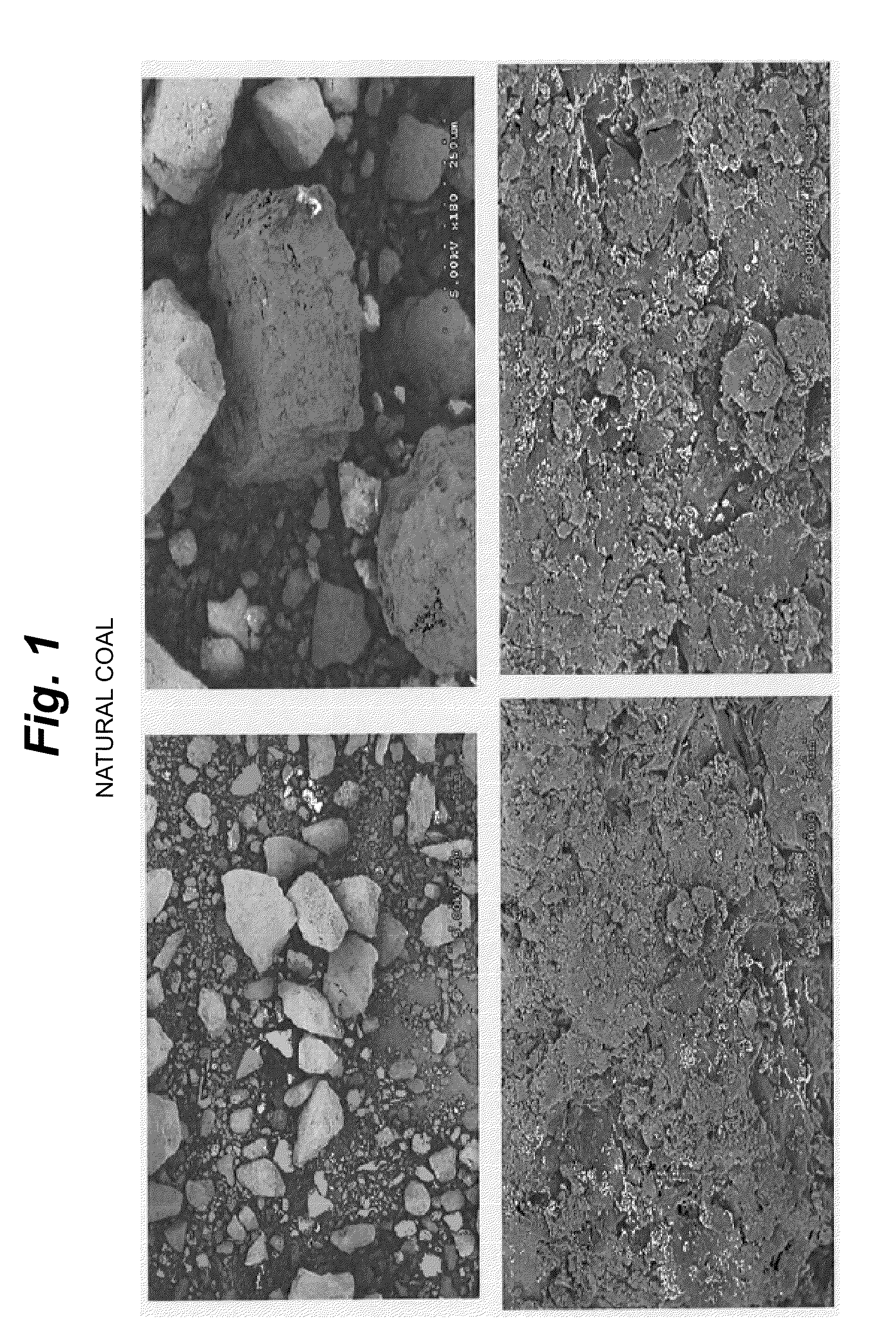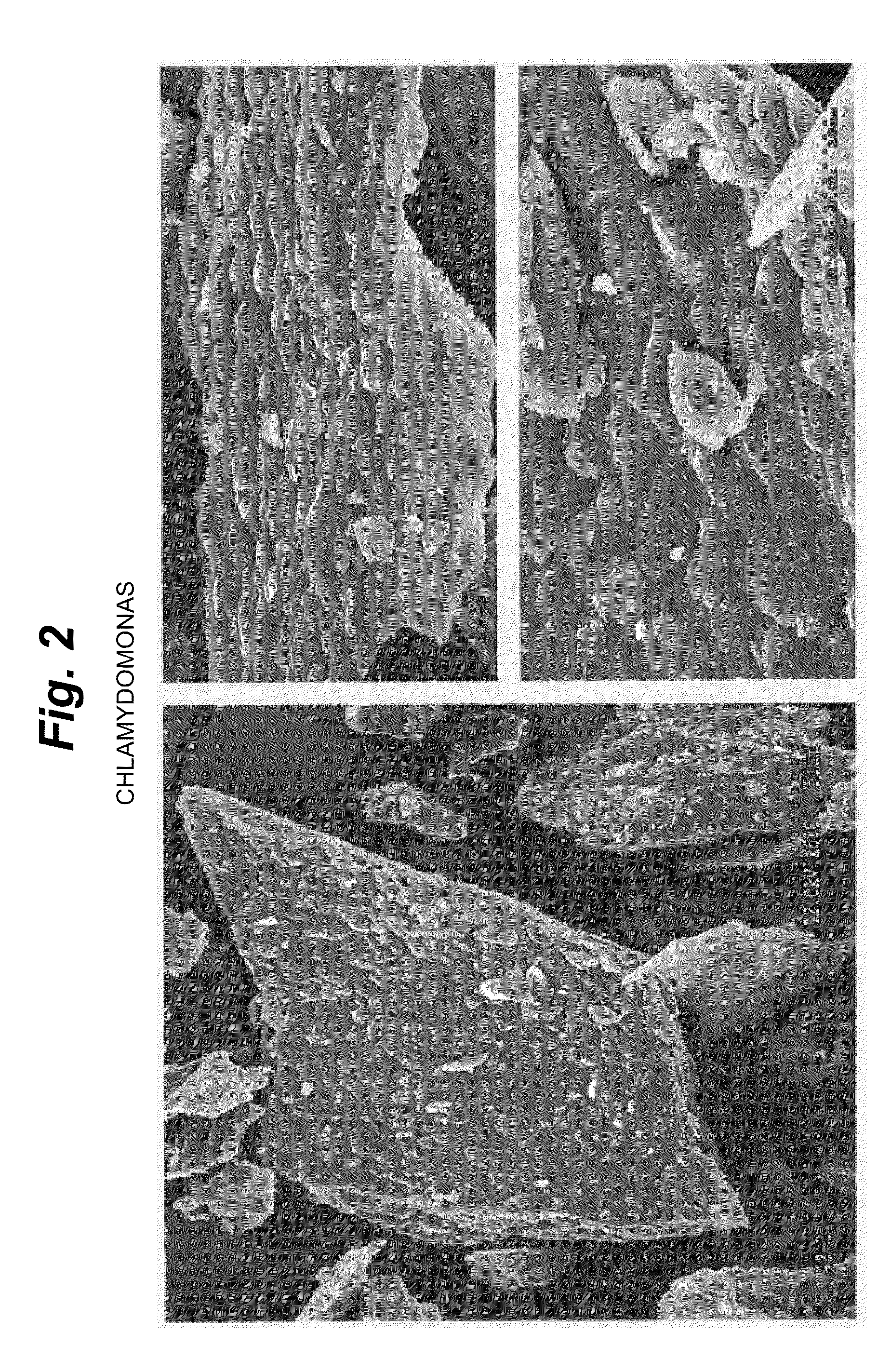Algal Coal and Process for Preparing Same
a technology applied in the field of algal coal and process for preparing same, can solve the problems of increasing problems, natural coal is generally regarded as a non-renewable energy source, etc., and achieves the effects of reducing environmental impact, reducing gaseous output, and reducing gaseous outpu
- Summary
- Abstract
- Description
- Claims
- Application Information
AI Technical Summary
Benefits of technology
Problems solved by technology
Method used
Image
Examples
examples
[0062]Unless specifically mentioned otherwise, the following equipment, sources and parameters were utilized in the following examples.
[0063]Reactors employed in the examples were of two types: a 71 mL unstirred stainless steel reactor and a 450 mL stirred stainless steel reactor, both of which were purchased from Parr Instruments, Inc. (Moline, Ill.). Heating methods were of two types: an induction heating system (available from LC Miller, Co., Monterey Park, Calif.) and a resistive heating mantle arrangement (available from Parr Instruments, Inc). Rates of heating varied between the two arrangements, with the inductively heated system achieving the desired temperature more rapidly, but no differences in products were detected with the two methods.
[0064]Chlamydomonas rheinhardii CC-125 wild type mt+137c was obtained and used to inoculate 20 L carboys filled with 18 L of TAP medium (D. S. Gorman and R. P. Levine, Proc. Natl. Acad. Sci. USA 1965, 54, 1665-1669). Synechocystis sp. PCC...
examples 1-5
[0065]Examples 1 through 5 were performed to evaluate the effect of varying temperature parameters during hydrothermal carbonization using starting alga Chlamydomonas rheinhardii.
[0066]Freeze-dried Chlamydomonas rheinhardii (3.0 grams), citric acid (0.09 gram; 3 weight percent based on alga), and 40 mL of deionized water were shaken and vortexed briefly in a 50 mL centrifuge tube. Once dispersed completely, the contents were poured into the 71 mL unstirred reactor, and the centrifuge tube was washed of any remaining material with 17 mL of water.
[0067]The reactor was sealed and heated inductively to a set point of 210° C. (set points were typically exceeded by 6-7° C. with the induction heating system, so the average temperature was actually 213° C.). The reaction period at a given set temperature was two hours. When cool, the contents were vacuum filtered, and the undiluted aqueous filtrate was isolated and stored in the refrigerator. The moist filtered synthetic coal was washed wi...
examples 6-13
[0069]Examples 6 through 13 were conducted to evaluate the effectiveness of various buffers and catalytic agents in the hydrothermal carbonization process. A companion reaction with no additive, and alga that had been washed using a cross-flow filtration system to remove any metal salt solutes that may have been present, was prepared as a control. Other additives (Examples 7-13) were also evaluated at the same molar level as CaCl2 of Example 6. The reaction temperature for each example was 213° C. with a reaction time of two hours. The remaining equipment, sources and conditions were similar to those described above in Example 1. The resulting data is set forth in the following Table 3.
TABLE 3Comparative Data using Various Additives% YieldExampleAdditive% CSynthetic CoalControlNone62.329 6CaCl258.928 7Citric acid61.431 8MgCl2**56.629 9Oxalic acid**65.93110FeCl362.33711Boric acid**65.23312AlCl3**64.23513H2SO466.031**Additive was reported to be effective catalytic agent in Japanese Ni...
PUM
| Property | Measurement | Unit |
|---|---|---|
| heat of combustion | aaaaa | aaaaa |
| pressure | aaaaa | aaaaa |
| temperature | aaaaa | aaaaa |
Abstract
Description
Claims
Application Information
 Login to View More
Login to View More - R&D
- Intellectual Property
- Life Sciences
- Materials
- Tech Scout
- Unparalleled Data Quality
- Higher Quality Content
- 60% Fewer Hallucinations
Browse by: Latest US Patents, China's latest patents, Technical Efficacy Thesaurus, Application Domain, Technology Topic, Popular Technical Reports.
© 2025 PatSnap. All rights reserved.Legal|Privacy policy|Modern Slavery Act Transparency Statement|Sitemap|About US| Contact US: help@patsnap.com



